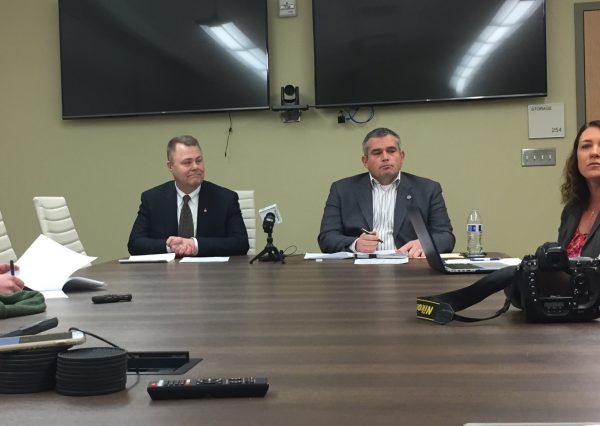
The Blood Bank of Alaska did not put residents at risk by mismanaging the state’s blood supply this summer, according to a 23-page report, detailed during a press conference held at the organization’s new building.
But according to the whistle-blower who filed a complaint with the U.S. Food and Drug Administration, that’s not true.
The accusations were first made public in reporting by the Alaska Journal of Commerce, and included charges that the Blood Bank had over-exported critical blood supplies in order to meet debt requirements taken on when it moved into the new building.
BBA CEO Bob Scanlon said that a substantive investigation showed that effectively every negative claim in the complaint has been proven inaccurate.
“The accusations that have been leveled against us are meritless,” Scanlon said, reading from prepared remarks
The report released Friday includes detailed findings drawn from three recently conducted independent audits and employee interviews. The report was prepared by three investigators, all of whom are BBA board members.
Ryan York chairs the board, and explained to reporters that the decision not to include any outside investigators was due to the exceptionally complex finances and regulations involved in blood banking, which required a level of familiarity the board didn’t expect to find locally.
“It was agreed from the beginning that if the committee found that any of the allegations warranted or needed further investigation, an outside party would be consulted and a budget of $25,000 was provided for them to do so,” York said. “The committee’s access was unfettered in terms of the data and documents they could request, and the individuals they could speak with. No issues were found, and no parties were retained.”
BBA officials spent more than an hour sharing the report’s findings and taking questions from reporters. They provided numbers refuting the claim the Blood Bank had lost donors because of overly aggressive recruitment tactics, and attributed persistent robo-calls to a glitch in a new telephone system, which has since been fixed.
Scanlon also denied there were ever abnormal blood shortages this summer. The detail is tied to a part of the formal complaint alleging just a few bags of a critical blood type were on hand at the Blood Bank. That’s because most of the state’s blood isn’t stored at the bank, but at hospitals in Anchorage and around the state. Scanlon attributed many of the accusations made by the former employee to misunderstandings about how the “blood industry” works.
“I think it’s lack of knowledge,” he said. “We’re talking about a development department person who is a grant writer stating what the best process for managing inventory is.”
The FDA complaint was filed by Linda Soriano, who said in a phone interview late Friday evening she was one of six employees that contributed to it. Soriano disagrees with the report’s findings and BBA’s claims about blood supply.
“It’s misleading to the point of being a lie to say they only store a small amount of blood in that blood bank,” she said.
Soriano has spent years involved in the financing side of Alaska’s healthcare systems, and disputes Scanlon’s characterization of her as unfamiliar with operations. She sees the audited materials as only capturing a small sliver of the Blood Bank’s overall function and management. On top of that, the report used audit materials drawing from before BBA’s move to it’s new location, which is when Soriano believes the financial pressure to meet an larger debt burden and rising costs actually began.
“All of the financial problems, all the inventory problems that I referred to in the FDA complaint began when we moved into the new building in February,” she said.
Soriano said employees were misled about financial details in the Blood Banks budgeting, and she alleges the board’s perspective on the complicated business of blood banking is out of step with what employees see day to day.
When asked why the Blood Bank has been so tight-lipped in the last few months answering questions from the press, York, the board chair, said it had to do with the organizations lack of familiarity handling “crisis management” public relations. They have since retained representation from KD/PR Virtual, which describes itself as “Alaska’s most experienced full-service PR firm,” and who’s president was on-hand for Friday’s press conference.
Zachariah Hughes reports on city & state politics, arts & culture, drugs, and military affairs in Anchorage and South Central Alaska.
@ZachHughesAK About Zachariah




